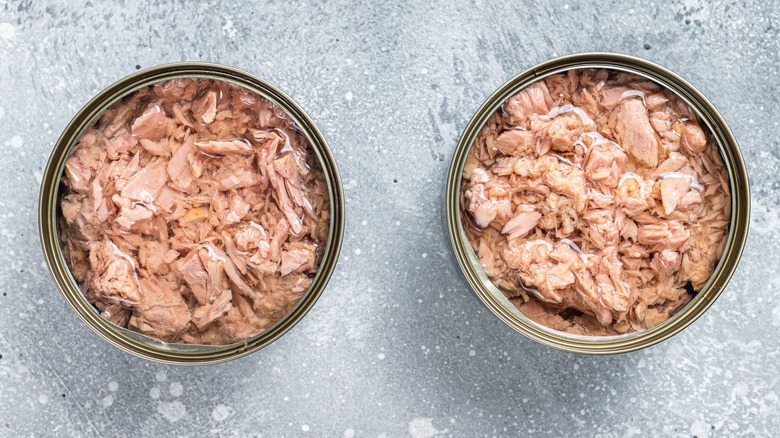The Big Nutritional Difference Between Canned Tuna And Fresh Tuna
Whether you prefer tuna salad, tuna casserole, or a tuna melt sandwich, this versatile fish pairs well with nearly any meal you can think of. Offering a uniquely meaty flavor, various species of tuna can be found throughout different parts of the world. In most U.S. grocery stores, for example, you'll likely find the popular skipjack tuna or albacore tuna, reports WebMD.
Either way, tuna as a whole has a lot to offer our health. For starters, tuna is jam-packed with omega-3 fatty acids. For this reason, eating tuna may help lower levels of "bad" cholesterol within the body and subsequently decrease our risk for heart disease and cardiovascular events. Similarly, the omega-3s found in tuna may also help minimize cancer risk by fighting inflammation. Not only that but eating tuna may also support healthy vision.
So what gives tuna the ability to do all this and more? The answer lies in its nutrients. Let's dive into all the vitamins and minerals that tuna can provide us with and how its nutritional value may differ between canned products and freshly caught fish.
Vitamin and mineral content in canned vs. fresh tuna
Protein, vitamin D, vitamin B6, iron, potassium, and iodine are just a few of the many nutrients to be found in tuna (via WebMD). Tuna is also free of carbohydrates and sugar. Between canned tuna and fresh tuna, however, you will find some minor differences. For example, a 100-gram serving of freshly cooked tuna (approximately 3.5 ounces) has a bit more protein to offer at 32.3 grams compared to the 24.9 grams of protein found in canned tuna of the same serving size, reports BBC Good Food. Additionally, this same serving of fresh tuna provides 92 micrograms of selenium compared to the 69 micrograms found in canned tuna packed in brine (salty water).
While you won't see much variation between fresh tuna and canned tuna when it comes to fat content, there is one major difference to note between the two: sodium levels. According to Healthline, a roughly 28-gram serving of fresh boneless tuna contains 13 milligrams of sodium, while the same serving of canned tuna packed in water has 70 milligrams. This number climbs to 118 milligrams of sodium for canned tuna packed in oil. While sodium is essential for the body, too much can increase one's risk for hypertension and cardiovascular disease.
Canned tuna packed in water vs. oil
While canned tuna may come with more sodium than fresh tuna, it doesn't mean that canned tuna should be avoided altogether. After all, canned tuna still houses a great deal of protein, vitamins, and minerals, and offers the same health benefits as fresh tuna.
Depending on one's health needs, however, some people may prefer canned tuna packed in water versus canned tuna packed in oil or vice versa. For example, if a person is focusing on weight loss, canned tuna packed in water will have fewer calories. Alternatively, researchers from a 2011 study published in Public Health Nutrition looked at the fat and fatty-acid makeup of eight different canned tuna products packed in either oil or water, including chunk white, light, and albacore tuna.
The research findings showed that light canned tuna packed in water may be a better source of omega-3 polyunsaturated fat for generally healthy individuals, while those with certain health conditions, such as cystic fibrosis, may be better served by the greater amounts of essential fatty acids provided by canned tuna packed in oil.



